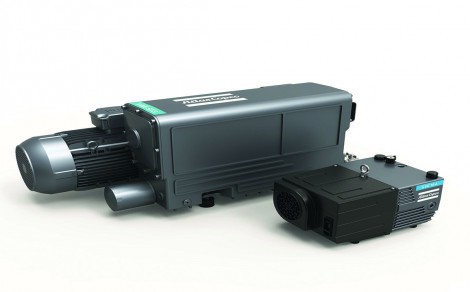The right vacuum pump for your application

In two-stage versions, two synchronised pump chambers work in series to achieve high performance at operating pressures below 200 mbar and improved efficiency on continuous process duties such as drying, degassing exhausting and solvent recovery.
Multiple units are also available, which combine between two and four dry claw vacuum pumps, depending on the application, in a single compact housing. In this configuration one of the pumps in each multiple unit features variable speed drive, allowing the vacuum to be adapted precisely to the application requirements. This results in improved efficiency and economy by reducing the power required and therefore reducing cost of ownership.
Volume flows for dry claw vacuum pumps vary between 65 and 1230 m3/h and units typically have an ultimate vacuum of 140 mbar(a). Some of the latest pumps on the market can reach 50 mbar(a).
Reduced maintenance, noise and heat emissions
Rotary Screw pumps are based on proven compressor screw technology and provide significantly higher performance levels and reduced maintenance, noise and heat emissions compared to conventional oil-sealed and dry vane vacuum pumps. With the application of variable speed drive, it’s possible to tailor vacuum production to precisely meet process demand. When installed as part of a central vacuum system, energy consumption can be reduced by up to 50%. With a maximum flow rate in the region of 5004 m3/h, they are particularly suited for large industrial vacuum users in the glass, plastics, canning and food packaging industries.
This technology has been designed for specific industries and is optimised to perform at 400 mbar and below. At operating pressures above that, and in certain applications, other types of vacuum pump technology may be more suitable. For instance, a dry claw pump on a conveying line in a harsh operating environment, or a liquid ring pump where excess water is present, or an oil-injected vane pump in smaller point-of-use applications.
Rotary screw vacuum pumps are usually equipped with electronic process controllers and variable speed drive, which makes them extremely economical to run. Additionally, a pressure set point control function ensures the pumps deliver the lowest possible vacuum flow with which the required vacuum can be maintained. As a result, no excess energy is wasted and life cycle operating expenses are significantly reduced.
Finally, it’s also worth considering the merits of remote monitoring when specifying an industrial vacuum pump. Recent advances in connectivity technology mean that central vacuum systems and individual machines can now transmit live performance data to a company’s engineering team via their smartphone, PC or tablet. This makes it possible for plant and service engineers to receive all the information required to take a proactive approach to the maintenance of their industrial vacuum pumps: from machine alarms and faults to visualised representations of demand and load for complete site installations.
-
PPMA 2025
23 September, 2025, 9:30 - 25 September, 2025, 16:00
NEC, Birmingham UK -
Advanced Engineering Show 2025
29 October, 2025, 9:00 - 30 October, 2025, 16:00
NEC, Birmingham UK










